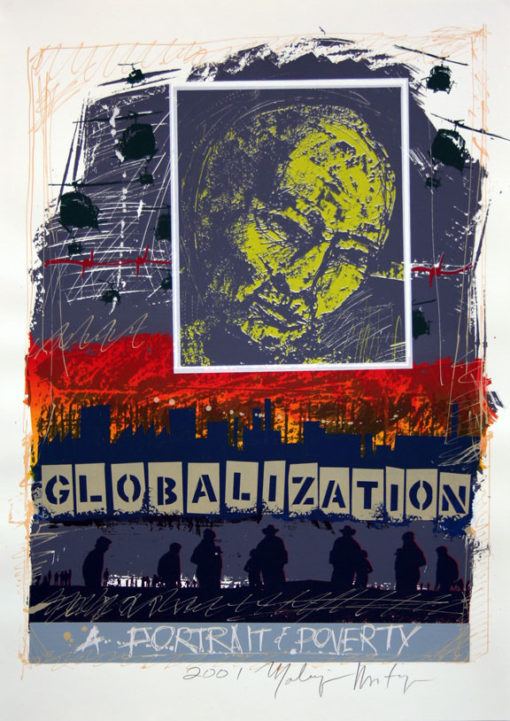
A Portrait of Poverty by Malaquias Montoya. Courtesy Ave. 50 Studio.
Along the Border/ A lo Largo de la Frontera art exhibition at Ave 50 Studio in Highland Park, CA presents Chicano artist Malaquias Montoya. His art is a reminder of a continuous struggle. Montoya’s point of reference is the border, accentuated with barbed wire named by Native Americans as the Devil’s rope. As a modern instrument for setting boundaries, the barbed wire was unknown to Native American communities. A strong divisive symbol whose origins date from the 1830s is historically tied to the western movement; the Anglo colonization of the west as they attempted to bring space under control. It became an unprecedent way of imprisoning lives during colonization. The barbed wire is a recurring symbol that crosses into his posters, paintings and murals. It singles out the painful experience immigrants endure as they voyage through Mexico and across the U.S Mexican border.
Malaquias Montoya was born in Albuquerque, New Mexico and raised in the San Joaquin Valley of California. He is one of seven children brought up by farm working parents who could not read or write. His parents divorced when he was 10 years old leaving his mother as the sole provider for the four remaining children at home. Montoya’s mother toiled the fields of the San Joaquin Valley so her children could continue their education. In 1969 Montoya graduated from UC Berkeley and teaches at UC Davis. His courses include silk-screening, poster making and mural painting with an emphasis on Chicano culture history.
Montoya’s work is described by art historian, Dr. Ramon Favela, “with strident forms of simplicity and power the message conveyed by Montoya’s poster are exceedingly clear…his images are of a dispossessed humanity restrained and shackled by an incomprehensible and nefarious political condition.”
In his 2001 large size A Portrait of Poverty poster, Montoya juxtaposes a herd of choppers in a seek and destroy formation above red jagged edge buildings and a portrait of what seems to be an elder man below an incoming destruction. His strong use of sharp angled lines is one of his defining characteristics in his art making process.
Yo Vengo del Otro Lado (I Come from The Other side, 1994), a silkscreen poster is a dynamic testament that tears open the very same poster it is printed on. In Yo Vengo del Otro Lado thick black lines take on the shape of an anonymous person accompanied by three smaller images of the same portrait in red that simulate the likeness of a Japanese seal. It is Montoya’s stamp of acknowledgement of immigrants from all regions of Central America and Mexico who go unnoticed. It is this strong combination between black and red ink that confronts the viewer with images that provoke distraught. Montoya’s approach to his work is an attempt to honor the everyday struggles people face. His work encompasses 4 cardinal points: dignity, resistance, protest and strength. He does not capitulate his spirit of resistance to the production of art for the sake of art. Despite his strong imagery, there is a sensibility of concern for humanity and the environment.
Virgin Campesina an acrylic painting on 4×5 canvas is the spiritual support for campesinos (farmers) who’s struggle consists of living one day at a time (‘Un Dia a La vez’ by the Mexican music band Los Tigres del Norte) with the hopes that each accumulated day can add to a promising tomorrow. Montoya is not two feet ahead nor two feet behind working people, farmers and students, he is side by side with them. It is a portrait of the Virgin Campesina that catches a pencil in defiance that is rooted in Montoya’s political art. This thirteen-exhibiting art pieces are a frozen mirror that no longer allows the lies and false illusions reflect a reality that is centered on racism and scapegoating. This exhibition is Montoya’s wrench jammed into the capitalist image producing machine that holds back the hateful manufacturing with his solidarity and commitment to social causes. For every one of Montoya’s image of protest and denouncement there are five if not more that are devoid of any critique against discriminating methods and racializing laws.
The exhibition can be viewed until October 7, 2017.
http://www.malaquiasmontoya.com/bio.php (Malaquias Montoya website)